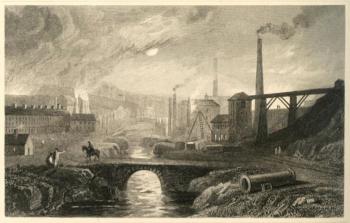SOLOMONS, MD (August 25, 2016)—Close to 200 years ago, the Industrial Revolution drove thousands away from working the land to toil in factories in cities, where machine production changed our entire way of life. A new study shows that this major societal shift also triggered simultaneous changes in our climate. An international research project has shown that the increases in temperatures we are witnessing today started about 180 years ago and confirms previous findings that human activity is the cause of modern global warming.
 The study found the earliest signs of greenhouse-induced warming began during the early stages of the Industrial Revolution and is first detectable in the Arctic and tropical oceans around the 1830s, followed soon after by Europe, Asia and North America—much earlier than scientists had expected.
The study found the earliest signs of greenhouse-induced warming began during the early stages of the Industrial Revolution and is first detectable in the Arctic and tropical oceans around the 1830s, followed soon after by Europe, Asia and North America—much earlier than scientists had expected.
“The Industrial Revolution really ramped up in the early- to mid-1800s and emissions ramped up at the same time, “ said paleclimatologist Hali Kilbourne of the University of Maryland Center for Environmental Science. “The surprise was there was no lag time between the bump in emissions and the global warming—it happened at essentially the same time.”
The new findings have important implications for assessing the extent that humans have caused the climate to move away from its pre-industrial state, and will help scientists understand the future impact of greenhouse gas emissions on the warming climate.
 “It demonstrates that the climate does respond quickly to greenhouse gas levels,” said Kilbourne. “If we can change things fast now, it bodes well for the ability of the system to respond. The sooner we are able to reduce our greenhouse gases, the sooner the system will respond.”
“It demonstrates that the climate does respond quickly to greenhouse gas levels,” said Kilbourne. “If we can change things fast now, it bodes well for the ability of the system to respond. The sooner we are able to reduce our greenhouse gases, the sooner the system will respond.”
The research involved 25 scientists from across Australia, the United States, Europe and Asia, working together as part of an international grass-roots effort to compile data from natural archives of climate spanning the last 2000 years, known as the Past Global Changes (PAGES) 2K network. PAGES is an international project to coordinate and promote research on past global change and is part of the Future Earth network to advance global sustainability research.
Human caused climate change is usually talked about as a 20thand 21st century phenomenon because direct measurements of temperature are not globally widespread before the late 1800s. However, the team studied detailed reconstructions of temperature spanning the past 500 years to identify when the current sustained warming trend really began.
To do this, the team of scientists examined hundreds of natural records of temperature across the world’s oceans and continents. These included temperature histories preserved in corals, sediment layers, stalactites in caves, tree rings and ice cores.
 For example, the chemistry of coral skeletons can record the temperature of the oceans like a thermometer. Kilbourne, who studies paleoclimate records to understand how our climate is changing today and what could happen in the future, was involved with analysing the data from corals, which can reveal annual changes in temperature going back hundreds of years.
For example, the chemistry of coral skeletons can record the temperature of the oceans like a thermometer. Kilbourne, who studies paleoclimate records to understand how our climate is changing today and what could happen in the future, was involved with analysing the data from corals, which can reveal annual changes in temperature going back hundreds of years.
Corals calcify in the seawater, pulling elements right out of the water to build their skeletons. One of those elements is strontium. Comparing corals’ chemistry to modern day measurements taken with thermometers, scientists can tell the temperature of the sea water hundreds of years ago by how much strontium has been taken up by the coral. It increases when the water temperature goes down, decrease when the ocean warms up.
“The corals can go back 300-400 years so we could capture the onset of global warming fairly well,” she said.
The research team also analysed many thousands of years of climate model simulations, including experiments used for the latest report by the UN’s Intergovernmental Panel on Climate Change (IPCC), to determine what caused the early warming, natural or human causes. The data and simulations together pinpointed the early onset of warming to around the 1830s, and found the early warming was attributed to rising greenhouse gas levels linked to the Industrial Revolution.
The conclusion was clear. “It’s us,” said Kilbourne. “We did it.”
The research, “Early onset of industrial-era warming across the oceans and continents,” is published in the latest edition of Nature.
Photo credits:
England during early Industrial Era. Picture by Henry Gastineau of ironworks in South Wales during the Industrial Revolution c.1820.
Paleoclimatologist Hali Kilbourne. Photo by Cheryl Nemazie.
Example of a coral that can hold temperature records from hundreds of years ago in its skeleton.

